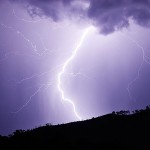Florida’s Emergency Management officials are reminding residents and visitors that June 20-26, 2010 is Lightning Safety Awareness Week. Hurricanes and tornadoes are not the only kinds of hazardous weather in the Sunshine State; Florida is the lightning capital of North America with an average of 1.4 million cloud-to-ground lightning strikes per year.
 “Lightning is a serious and deadly threat, especially in Florida where thunderstorms form quickly,” said David Halstead, director of the Florida Division of Emergency Management. “Floridians should pay close attention to changing weather conditions when outdoors and seek shelter when thunder is heard.”
“Lightning is a serious and deadly threat, especially in Florida where thunderstorms form quickly,” said David Halstead, director of the Florida Division of Emergency Management. “Floridians should pay close attention to changing weather conditions when outdoors and seek shelter when thunder is heard.”
On average, lightning strikes are responsible for more weather-related deaths annually in Florida than hurricanes and tornadoes combined. In 2009, 34 people died from lightning strikes nationally, including 5 Floridians.
When Thunder Roars, Go Indoors!
Thunderstorms are a common occurrence in Florida and all thunderstorms produce lightning. Did you know that lightning can travel horizontally from thunderstorm clouds and strike as far as 10 miles away from any rainfall? Residents should know that if they hear thunder, they are in danger of being struck by lightning and should seek safe shelter immediately.
The most dangerous place to be during a thunderstorm is in an open area. Nearly half of all lightning deaths occur in open areas. Trees may offer shelter from the rain, but provide no protection from lightning. Covered picnic shelters, tents and convertibles also offer no protection from lightning. During a thunderstorm, the safest place to be is in a building, such as a home, away from the windows. Vehicles with metal roofs also provide safe shelter from lightning.
Florida emergency management officials encourage families and businesses to incorporate the “30/30 Rule” when conducting outdoor activities. This two-part rule states that people should first seek immediate shelter once the time between a lightning flash and thunder is 30 seconds or less. The second part of this rule states that people should remain in safe shelter for 30 minutes following the final clap of thunder. Many lightning strike victims assumed that the threat had passed once a thunderstorm’s rains had ended, when in fact lightning can travel far from the core of a storm’s downpours.
Floridians should always be aware of weather conditions when participating in activities outdoors and have a plan in case thunderstorms develop. A portable NOAA all-hazards radio will provide weather forecast updates and can audibly alert you if a severe thunderstorm watch or warning is issued. To learn more go to www.lightningsafety.noaa.gov.
If a person is struck by lightning, call 911 and get medical help immediately. Lightning strikes can cause cardiac arrest, burns and nerve damage. Bystanders are in no danger by initiating medical aid and CPR; the victim will not carry an electrical charge. Some deaths can be prevented if the victim receives the proper first aid immediately.
For more information on the Florida Division of Emergency Management and to GET A PLAN!, please visit: www.FloridaDisaster.org. Follow us on Twitter at www.Twitter.com/flsertinfo or join our blog at: http://flsertinfo.blogspot.com/.


